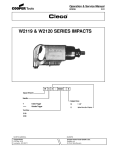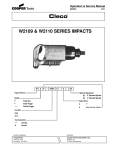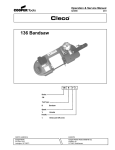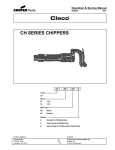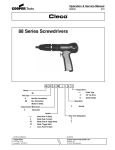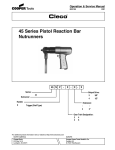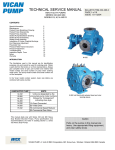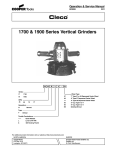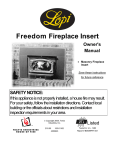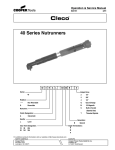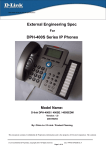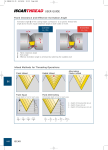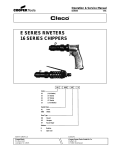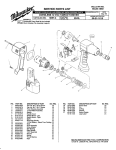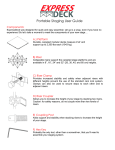Download WP2049 & WP2050 SERIES IMPACTS
Transcript
Operation & Service Manual
823033
2/01
WP2049 & WP2050 SERIES IMPACTS
W
P
S
-
XXXX
-
X
Impact Wrench:
Handle:
P
Pistol Grip
Output Drive:
Tool Size:
2049
5
5/8"
6
3/4"
2050
Q
Quick Change
R
Ring Retainer
NORTH AMERICA
EUROPE
CooperTools
P.O. Box 1410
Lexington, SC 29071
Cooper Power Tools GmbH & Co.
Postfach 30
D-73461 Westhausen
1
SafetyRecommendations
For your safety and the safety of others, read and understand
the safety recommendations before operating an impact
wrench.
nel, clear air hose of accumulated dust and moisture. Before
removing a tool from service or changing sockets, make sure
the air line is shut off and drained of air. This will prevent the tool
from operating if the throttle is accidently engaged.
Always wear protective equipment and clothing.
!
WARNING
Impact resistant eye protection
must be worn while operating
or working near this tool.
For additional information on eye protection, refer to Federal
OSHA Regulations, 29 CFR, Section 1910.133, Eye and Face
Protection, and ANSI Z87.1, Occupational and Educational Eye
and Face Protection. This standard is available from the
American National Standards Institute, Inc., 11 West 42nd
Street, New York, NY 10036.
!
CAUTION
Personal hearing protection is
recommended when operating
or working near this tool.
Hearing protection is recommended in high noise areas
(above 85 dBA). Close proximity of additional tools, reflective
surfaces, process noises, and resonant structures can substantially contribute to the sound level experienced by the
operator. Proper hearing conservation measures, including
annual audiograms and training in the use and fit of hearing
protection devices may be necessary. For additional information on hearing protection, refer to Federal OSHA Regulations,
29 CFR, Section 1910.95, Occupational Noise Exposure, and
American National Standards Institute, ANSI S12.6, Hearing
Protectors.
• Gloves and other protective clothing should be worn as
required, unless they create a greater hazard.
• Do not wear loose fitting clothing, or clothing that may
restrict movement, become entangled or in any way
interfere with the safe operation of the impact.
Cleco impact wrenches are designed to operate on 90 psig (6.2
bar) maximum air pressure. If the tool is properly sized and
applied, higher air pressure is unnecessary. Excessive air
pressure increases the loads and stresses on the tool parts,
sockets, and fasteners and may result in breakage. Installation
of a filter-regulator-lubricator in the air supply line ahead of the
tool is highly recommended.
Before the tool is connected to the air supply, check the throttle
for proper operation (i.e., throttle moves freely and returns to
closed position). Being careful not endanger adjacent person-
2
Never use the air hose for supporting, lifting, or lowering the
tool. Use a safety line or cable on the tool when working in
elevated areas.
Tools with exposed throttles should not be used where obstructions can hold the throttle in the “on” position. An impact
wrench operating in reverse will move backwards as a nut is
removed and can trap an operator's hand, making it difficult to
release an outside trigger. Inside trigger or pistol grip tools are
advised for close quarter operation.
Only use sockets designed for use with impact wrenches.
Never use a hand tool socket on an impact wrench. Hand tool
sockets can break, resulting in a hazard from flying pieces.
Inspect sockets, retainers, and drives regularly for wear or
damage, and replace as necessary. Worn sockets reduce
power, cause drive wear, and increase the chance for breakage
and should not be used.
!
WARNING
Repetitive work motions and/or vibration
may cause injury to hands and arms.
Use minimum hand grip force consistent
with proper control and safe operation.
Keep body and hands warm and dry.
Avoid anything that inhibits blood circulation.
Avoid continuous vibration exposure.
Keep wrists straight.
Avoid repeated bending of wrists and hands.
Some individuals may be susceptible to disorders of the hands
and arms when performing tasks consisting of highly repetitive
motions and/or exposure to extended vibration. Cumulative
trauma disorders such as carpal tunnel syndrome and tendonitis may be caused or aggravated by repetitious, forceful
exertions of the hands and arms. Vibration may contribute to a
condition called Raynaud's Syndrome. These disorders develop gradually over periods of weeks, months, and years. It is
presently unknown to what extent exposure to vibrations or
repetitive motions may contribute to the disorders. Hereditary
factors, vascular or circulatory problems, exposure to cold and
dampness, diet, smoking and work practices are thought to
contribute to the conditions.
SafetyRecommendations
Tool operators should be aware of the following warning signs
and symptoms so that a problem can be addressed before it
becomes a debilitating injury. Any user suffering prolonged
symptoms of tingling, numbness, blanching of fingers, clumsiness or weakened grip, nocturnal pain in the hand, or any
other disorder of the shoulders, arms, wrists, or fingers is
advised to consult a physician. If it is determined that the
symptoms are job related or aggravated by movements and
postures dictated by the job design, it may be necessary for the
employer to take steps to prevent further occurrences. These
steps might include, but are not limited to, repositioning the
workpiece or redesigning the workstation, reassigning workers to other jobs, rotating jobs, changing work pace, and/or
changing the type of tool used so as to minimize stress on the
operator. Some tasks may require more than one type of tool
to obtain the optimum operator/tool/task relationship.
BAD POSTURE
Also note that various tool wraps are available from a number
of different manufacturers. Like gloves, these wraps are also
intended to reduce and moderate the effects of extended
vibration exposure. They vary widely in design, material, thickness, vibration reduction, effectiveness, and durability, so
consideration must be given to choosing the proper wrap for the
specific application.
This information is a compilation of general safety practices
obtained from various sources available at the date of production. However, our company does not represent that every
acceptable safety practice is offered herein, or that abnormal
or unusual circumstances may not warrant or require additional procedures. Your work may require additional specific
safety procedures. Follow these procedures as required by
your company.
WARNING
!
OVER
Repetitive work motions and/or vibration
can cause injury to hands and arms.
Use minimum hand grip force consistent with
proper control and safe operation.
Keep body and hands warm and dry.
Avoid anything that inhibits blood circulation.
Avoid continuous vibration exposure.
Keep wrists straight.
Avoid repeated bending of wrists and hands.
CAUTION
!
Personal hearing protection is
recommended when operating
or working near this tool.
Hearing protection is recommended in high noise
areas (above 85 dBA). Close proximity of other
tools, reflective surfaces, process noises, and
resonant structures can substantially contribute
to the sound level experienced by the user.
WARNING
!
Impact resistant eye protection
must be worn while operating
or working near this tool.
Read Operating Instructions carefully. Follow
the Safety Recommendations for your safety
and the safety of others.
• Tasks should be performed in such a manner that the
wrists are maintained in a neutral position, which is not
flexed, hyperextended, or turned side to side.
Do not remove this tag until
the operator of this tool has
read these safety precautions.
Warnings
The warnings found on these tools are an essential part of the
product. Warnings should be checked periodically for legibility.
Replace warnings when missing or when the information can
no longer be read. Replacements can be ordered as any spare
part.
GOOD POSTURE
• Stressful postures should be avoided. Select a tool
propriate for the job and work location.
the glove manufacturer be consulted for gloves designed for
your specific application. WARNING! Proper fit of gloves is
important. Improperly fitted gloves may restrict blood flow to
the fingers and can substantially reduce grip strength.
ap-
The following suggestions will help reduce or moderate the
effects of repetitive work motions and/or extended vibration
exposure.
• Use a minimum hand grip force consistent with proper
control and safe operation
• Keep body and hands warm and dry
• Avoid anything that inhibits blood circulation
—Smoking Tobacco
—Cold Temperatures
—Certain Drugs
• Keep wrists as straight as possible
• Avoid highly repetitive movements of hands and wrists,
and continuous vibration exposure
869976
For more information, see the latest edition of ANSI B186.1,
Safety Code for Portable Air Tools, available from the American National Standards Institute, Inc., 11 West 42nd Street,
New York, NY 10036.
These operating instructions and service manual should
accompany tool if it is subsequently sold or ownership is
changed.
Work gloves with vibration reducing liners and wrist supports
are available from some manufacturers of industrial work
gloves. These gloves are designed to reduce and moderate the
effects of extended vibration exposure and repetitive wrist
trauma. Since they vary widely in design, material, vibration
reduction, and wrist support qualities, it is recommended that
3
OPERATING INSTRUCTIONS
OPERATION
The WP-2049 and WP-2050 Impact Wrench is designed to
operate on 90 psig (6.2 bar). The minimum hose size is
3/8" (10mm).
LUBRICATION
An automatic in-line filter-lubricator is recommended as it
increases tool life and keeps the tool in sustained operation.
The in-line lubricator should be regularly checked and filled
with a good grade of 10W machine oil. Proper adjustment of
the in-line lubricator is performed by placing a sheet of paper
next to the exhaust ports and holding the throttle open
approximately 30 seconds. The lubricator is properly set
when a light stain of oil collects on the paper. Excessive
amounts of oil should be avoided. In the event an in-line
lubricator is not used, the oil reservoir in the handle should
be utilized.
The oil reservoir marked "30W Oil" should not require
attention until the tool is torn down for inspection purposes.
However, if the tool is on the application for an unduly long
period of time, the plug should be removed and the reservoir
checked for the presence of oil. If oil is required, approximately 1/2 fluid ounce (16ml) of 30W oil should be added to
the oil reservoir.
REASSEMBLY
All parts should be cleaned in a solvent and inspected for
wear or damage. If rotor blades measure less than 5/16"
(7.9mm) on either end, they should be replaced. Rotor
bearings should be replaced if they show excessive looseness. Rotor shaft seals and the anvil seal should be
replaced if they are badly worn or no longer flexible.
Clean the bearing plates and anvil housing with a solvent
and coat the seal bores with "PERMATEX" Aviation Forma-gasket #3H. Allow to air dry at least four (4) minutes
before pressing in the seals. Press the rotor shaft seals into
the bearing plates with their "lips" facing outward (visible
after assembly). Press the anvil seal into the anvil housing
with its "lips" toward the rear of the housing ("lip" not visible
after assembly).
All impact mechanism and motor parts should receive a
thin coating of 30W oil before reassembly. Insert the cam
timing pin into the recess located on the small O.D. of the
cam and then install the cam and pin into the rear of the
hammer. Install the cam roller shaft in the cam shaft. Put
the cam roller on the roller shaft and slip the butt plate,
insulator, and shock absorber onto the rear of the cam
shaft. Hold the cam shaft vertically on the work bench with
the shock absorber down and tap the end of the cam shaft
with a soft mallet to seat the cam shaft in the shock
absorber.
SERVICE INSTRUCTIONS
Slip the cam shaft and related components through the
cam and hammer assembly. Install the hammer spring,
spring clip, and anvil pin onto the front of the cam shaft and
hammer assembly. Rotate the spring clip to accept the
anvil pin and then install the anvil on top of the assembly
(be sure the slot in the anvil lines up with the anvil pin) and
drive the anvil down until the spring clip engages the recess
in the anvil.
DISASSEMBLY
Loosen and remove the four (4), housing bolts. This will
allow the anvil housing and impact mechanism to be removed from the front of the motor housing. The motor unit
may now be slipped out the rear of the motor housing.
During the assembly of the motor unit, the rear of the rotor
can be identified by the "O"-ring, No. 869715, and the "O"ring groove located in the l.D. of the rotor bore. The cylinder
port "O"-rings can be coated with grease to retain them
during assembly of the motor unit.
Clamp the hammer, No. 869325, horizontally in a soft-jawed
vise and drive the anvil away from the hammer, using a soft
hammer. This will allow the anvil pin, No. 867437, spring
clip, No. 869336, and the hammer spring, No. 869345, to be
removed from the front of the cam shaft, No. 869322. This
will allow the cam shaft and related components to be
removed from the rear of the hammer.
During reassembly of the complete tool, 3/8 fluid ounces
(12ml) of 30W oil should be placed in the anvil housing.
Install the anvil housing on the tool with the straight flange
down (i.e., toward the trigger). Before installing the rear
cap, 1/4 fluid ounce (8ml) of 30W oil should be added to the
rear cavity of the rotor.
STORAGE
In the event that it becomes necessary to store the tool for
an extended period of time (overnight, weekend, etc.), it
should receive a generous amount of lubrication at that time
and again when returned to service. The tool should be
stored in a clean and dry environment.
Slip the two (2) bearing plates off the rotor and remove the
cylinder and six (6) rotor blades.
Unscrewing the air inlet bushing will allow the throttle valve
to be removed for inspection of the throttle valve seal.
Remove the air inlet screen for cleaning and inspection.
4
All tools should be tested after repair or replacement or
parts to ensure that they are functioning properly.
PARTS LIST — IMPACT MECHANISM
PART NO.
203997
203998
842455
843924
844077
861736
864710
864711
864712
865019
867437
869322
869325
869326
869329
869330
869331
NAME OF PART
Retainer Ring Anvil (incl. 203998)
Ring Retainer Kit (incl. "O"-ring & Ring)
Lock Washer
Socket Head Cap Screw
5/16" Steel Ball ("Q" Model)
Anvil Housing (incl. 869340,
869344, 869404)
Lock Pin Retainer Sleeve
Socket Lock Pin
Lock Pin Spring
Cam Roller
Anvil Timing Pin
Cam Shaft
Hammer
Cam
Shock Absorber
Insulator
Butt Plate
QTY.
PART NO.
1
1
4
4
1
869335
869336
869338
869339
869340
869344
869345
869346
869347
1
1
1
1
1
1
1
1
1
1
1
1
869351
869353
869354
869355
869356
869404
NAME OF PART
Hanger (Extra Equipment)
Spring Clip
Cam Timing Pin
Cam Roller Shaft
Anvil Housing Seal
Anvil Bushing
Hammer Spring
3/4" Sq. Dr. Anvil
5/8" Sq. Dr. Anvil (incl. 864710,
864711, 864712)
"Q" Model Anvil (5/8" internal hex)
Release Collar ("Q" Model)
Release Collar Spring ("Q" Model)
Release Collar Retainer ("Q" Model)
Release Collar Washer ("Q" Model)
Retainer Ring
QTY.
1
1
1
1
1
1
1
1
1
1
1
1
1
1
1
The "Q" Model anvil may be purchased as a complete subassembly using part no. 861858.
5
PARTS LIST — MOTOR UNIT
PART NO.
NAME OF PART
832117
843434
863399
863627
869321
869323
Alignment Pin
30W Oil Fill Plug
"O"- Ring 7/16" x 9/16"
Rotor Bearing
Rotor (incl. 869715)
Bearing Plate (WP-2049 Requires
one Only)
Back Cap Gasket
Motor Clamp Seal
869324
869332
6
QTY. PART NO.
1
1
2
2
1
2
1
1
869341
869343
869348
869352
869715
869741
869742
882311
NAME OF PART
Rotor Shaft Seal
Rotor Blade
Cylinder (WP-2050)
Rear Cap
"O"-Ring 15/16" x 1-1/16"
Rear Bearing Plate (WP-2049)
Cylinder (WP-2049)
"O"-Ring 1-15/16" x 2-1/8"
QTY.
2
6
1
1
1
1
1
1
PARTS LIST — MOTOR HOUSING
PART NO.
412775
619016
813449
833471
843571
844892
863072
869320
NAME OF PART
Screen
Retianer Ring
O-ring 5/16" X 1/2"
Inlet Bushing
Oiler Valve
10W Oil Fill Plug
Throttle Valve Spring
Motor Housing ( incl. 843571)
QTY.
PART NO.
2
1
1
1
1
1
1
1
869328
869337
869342
869349
869350
869712
NAME OF PART
Reversing Valve
Muffler
Trigger (incl. 869712)
Air Screen Sleeve
Throttle Valve
O-ring 5/64" X 13/64"
QTY.
1
1
1
1
1
1
The complete motor housing can be purchased as a complete subassembly using part no. 861737
7
CooperTools
670 Industrial Drive
Lexington, SC 29072
Phone: (803) 359-1200
Fax: (803) 359-2013
www.cooperindustries.com
8








